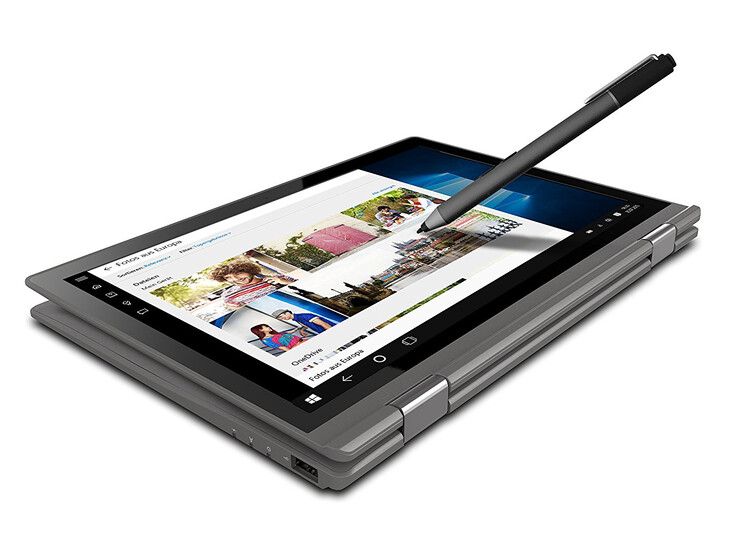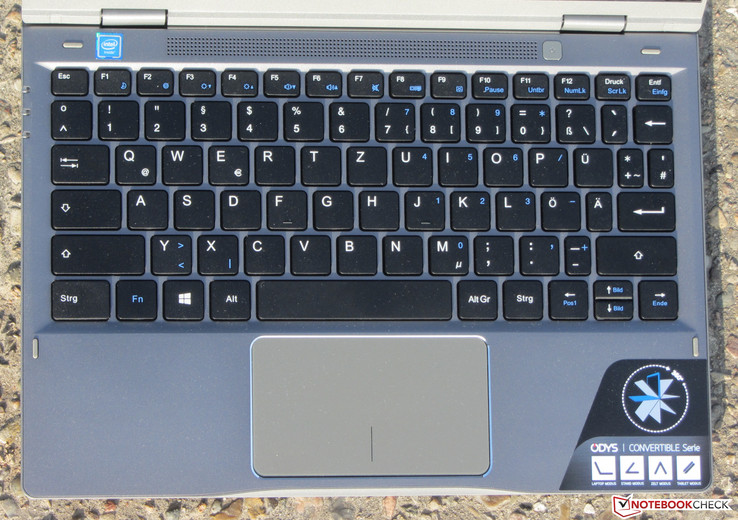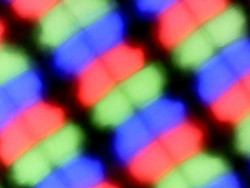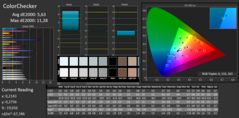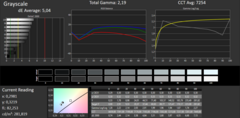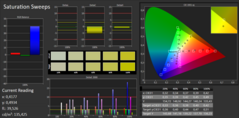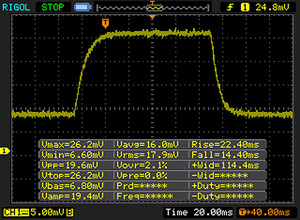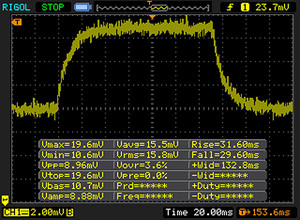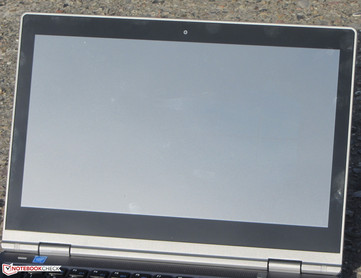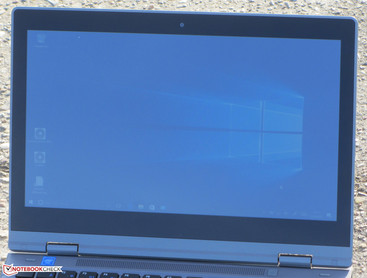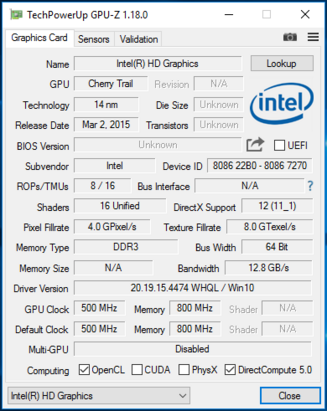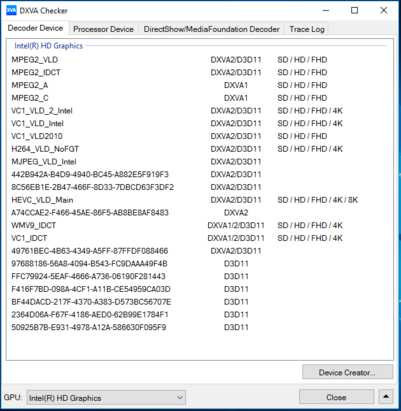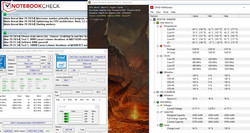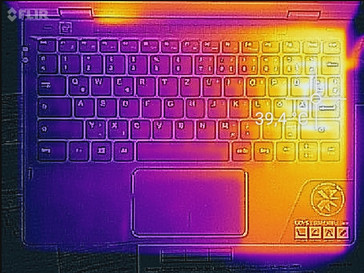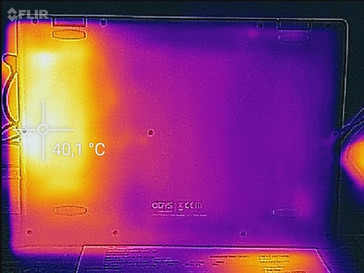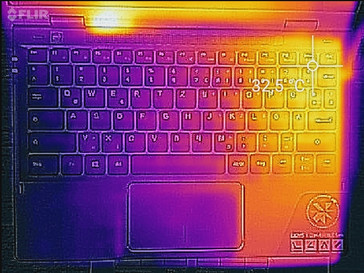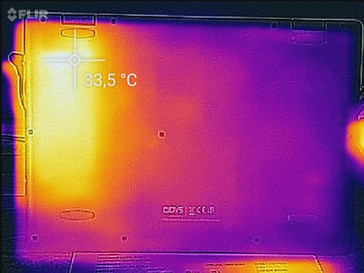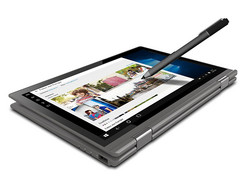ODYS Vario Pro 12 (Z8350, HD) Convertible Review

For the original German review, see here.
With the Vario Pro 12, Odys delivers an 11.6-inch Windows convertible. Inside the device there is an Atom quad-core processor of the Cherry Trail generation. Devices like the Medion Akoya E2215T and the HP x360 310 G1 can be considered its competitors.
Case and Equipment
With the Vario Pro, Odys is betting on an anthracite gray-colored casing. This is not a pure plastic case: the back of the lid and the top of the base are made from metal. In terms of the build there is nothing to criticize. The gaps are right and there are no perceptible protrusions. Also, in terms of stability there is not much to complain about. The base could be slightly stiffer. There is no maintenance hatch and the battery is built-in.
The convertible brings two USB Type-A jacks (1x USB 2.0, 1x USB 3.1 Gen 1). A micro-HDMI jack allows connecting an external monitor or TV. The built-in WLAN module carries a Realtek chip (RTL8723BS) which supports the 802.11 b/g/n WLAN standards - not the fast ac standard. The transmission speeds we got under optimal conditions (no other WLAN devices nearby, small distance between notebook and PC server) turned out poorly.
The 32-bit version of Windows 10 Home serves as the operating system. Since it goes easy on resources this is a favorite for use in under-performing systems. As a result, 64-bit applications cannot be run. But this is not a problem, since there is a 32-bit version of almost any application.
Odys encloses an active pen made from metal with the convertible. The power is provided by an AAAA-battery (included). A pen holder which can be inserted into the USB 2.0 jack is also supplied. The manual of the computer explicitly emphasizes that only the USB 2.0 jack and not the USB 3.1 Gen 1 jack should be used.
Connectivity
| SD Card Reader | |
| maximum SDCardreader Maximum Transfer Rate | |
| average SDCardreader Average Transfer Rate |
| Networking | |
| iperf3 transmit AX12 | |
| ODYS Vario Pro 12 | |
| iperf3 receive AX12 | |
| ODYS Vario Pro 12 | |
Input Devices
Odys equips the Vario Pro with a non-backlit chiclet keyboard. The flat, slightly rough keys possess a short stroke and a clear pressure point. The keystroke could be crisper for our taste. While typing, the keyboard flexes only minimally at most. This did not prove troubling. All in all, the Odys delivers a keyboard here that meets the demands of home use. The multi-touch-enabled ClickPad takes up an area of approximately 9.7 x 5.6 cm (3.8 x 2.2 in). So it offers enough space for using gesture control. The smooth pad surface makes it easy for the fingers to glide. The pad reacts to input in the corners as well. It possesses a short stroke and a clear pressure point.
The multi-touch-enabled touchscreen supports 10 touch points. It reacts to input promptly and did not give us any trouble. The screen can be manipulated with the fingers as well as the supplied active pen. Both work without problems. The pen has two button areas on the side. When the button on the bottom is pressed while drawing, the pen changes from the drawing to the erasing function.
Display
The 11.6-inch touchscreen display of the Vario Pro works with a native resolution of 1366x768 pixels. The brightness value of the screen (249.6 cd/m2) comes in too low. After all, this is a convertible that will be used in various locations and therefore under various lighting conditions. The contrast (762:1) is okay. Positive: at no time does the display show PWM-flickering.
| |||||||||||||||||||||||||
Brightness Distribution: 74 %
Center on Battery: 282 cd/m²
Contrast: 762:1 (Black: 0.37 cd/m²)
ΔE ColorChecker Calman: 5.63 | ∀{0.5-29.43 Ø4.77}
ΔE Greyscale Calman: 5.04 | ∀{0.09-98 Ø5}
67% sRGB (Argyll 1.6.3 3D)
43% AdobeRGB 1998 (Argyll 1.6.3 3D)
46.71% AdobeRGB 1998 (Argyll 3D)
67.5% sRGB (Argyll 3D)
45.16% Display P3 (Argyll 3D)
Gamma: 2.19
CCT: 7254 K
| ODYS Vario Pro 12 MS_9003, , 1366x768, 11.6" | Medion Akoya E2215T AU Optronics B116HAN03.1, , 1920x1080, 11.6" | HP x360 310 G1 Samsung SEC3953, , 1366x768, 11.6" | Trekstor SurfTab duo W3 Chi Mei N116HSE-DA2, , 1920x1080, 11.6" | |
|---|---|---|---|---|
| Display | 7% | -17% | 32% | |
| Display P3 Coverage (%) | 45.16 | 48.12 7% | 37.47 -17% | 63 40% |
| sRGB Coverage (%) | 67.5 | 71.7 6% | 56.4 -16% | 83.9 24% |
| AdobeRGB 1998 Coverage (%) | 46.71 | 49.78 7% | 38.71 -17% | 61.3 31% |
| Response Times | 38% | 30% | 41% | |
| Response Time Grey 50% / Grey 80% * (ms) | 60 ? | 31 ? 48% | 43 ? 28% | 37 ? 38% |
| Response Time Black / White * (ms) | 36 ? | 26 ? 28% | 25 ? 31% | 20 ? 44% |
| PWM Frequency (Hz) | 50 ? | 396 ? | ||
| Screen | 16% | -62% | 1% | |
| Brightness middle (cd/m²) | 282 | 338 20% | 199 -29% | 257 -9% |
| Brightness (cd/m²) | 250 | 309 24% | 186 -26% | 235 -6% |
| Brightness Distribution (%) | 74 | 76 3% | 76 3% | 80 8% |
| Black Level * (cd/m²) | 0.37 | 0.39 -5% | 0.8 -116% | 0.25 32% |
| Contrast (:1) | 762 | 867 14% | 249 -67% | 1028 35% |
| Colorchecker dE 2000 * | 5.63 | 3.94 30% | 11.92 -112% | 7.98 -42% |
| Colorchecker dE 2000 max. * | 11.28 | 9.96 12% | 20.52 -82% | 12.25 -9% |
| Greyscale dE 2000 * | 5.04 | 2.54 50% | 12.92 -156% | 7.87 -56% |
| Gamma | 2.19 100% | 2.38 92% | 2.04 108% | 2.3 96% |
| CCT | 7254 90% | 6902 94% | 13589 48% | 8815 74% |
| Color Space (Percent of AdobeRGB 1998) (%) | 43 | 46 7% | 36 -16% | 55 28% |
| Color Space (Percent of sRGB) (%) | 67 | 71 6% | 56 -16% | 84 25% |
| Total Average (Program / Settings) | 20% /
17% | -16% /
-41% | 25% /
12% |
* ... smaller is better
Screen Flickering / PWM (Pulse-Width Modulation)
| Screen flickering / PWM not detected | ||
In comparison: 53 % of all tested devices do not use PWM to dim the display. If PWM was detected, an average of 8083 (minimum: 5 - maximum: 343500) Hz was measured. | ||
Display Response Times
| ↔ Response Time Black to White | ||
|---|---|---|
| 36 ms ... rise ↗ and fall ↘ combined | ↗ 22 ms rise | |
| ↘ 14 ms fall | ||
| The screen shows slow response rates in our tests and will be unsatisfactory for gamers. In comparison, all tested devices range from 0.1 (minimum) to 240 (maximum) ms. » 93 % of all devices are better. This means that the measured response time is worse than the average of all tested devices (20.2 ms). | ||
| ↔ Response Time 50% Grey to 80% Grey | ||
| 60 ms ... rise ↗ and fall ↘ combined | ↗ 31 ms rise | |
| ↘ 29 ms fall | ||
| The screen shows slow response rates in our tests and will be unsatisfactory for gamers. In comparison, all tested devices range from 0.165 (minimum) to 636 (maximum) ms. » 96 % of all devices are better. This means that the measured response time is worse than the average of all tested devices (31.6 ms). | ||
Odys provides the Vario Pro with an IPS panel that is stable from wide viewing angles. The screen can be read from any angle. The convertible cannot be used outside. The low display brightness and reflective screen surface prevent that.
Performance
With the Vario Pro, Odys has a convertible of the 11.6-inch format in its line-up that is adequate for simple office and Internet application use. The device is supplied with an active pen. Our test device can be had for around 260 Euros (~$276). Other options are not available.
Processor
Inside the convertible we can find an Intel Atom x5 Z8350 (Cherry Trail) quad-core processor. The processor is designed for simple applications in the areas of the office or Internet. The low TDP (less than 4 watts) allows a passive cooling of the SoC. This is implemented here as well. The CPU works with a basic speed of 1.44 GHz. Via Turbo an increase up to 1.92 GHz is possible. The CPU tests we ran are processed at 1.7 GHz (multithread) and 1.7 to 1.92 GHz (single-thread). The behavior is identical during mains and battery operation.
| Cinebench R10 | |
| Rendering Multiple CPUs 32Bit | |
| ODYS Vario Pro 12 | |
| Trekstor SurfTab duo W3 | |
| Medion Akoya E2215T | |
| Lenovo IdeaPad MIIX 310-10ICR | |
| Rendering Single 32Bit | |
| Trekstor SurfTab duo W3 | |
| Medion Akoya E2215T | |
| ODYS Vario Pro 12 | |
| Lenovo IdeaPad MIIX 310-10ICR | |
| Geekbench 3 | |
| 32 Bit Single-Core Score | |
| ODYS Vario Pro 12 | |
| Trekstor SurfTab duo W3 | |
| Medion Akoya E2215T | |
| 32 Bit Multi-Core Score | |
| ODYS Vario Pro 12 | |
| Trekstor SurfTab duo W3 | |
| Medion Akoya E2215T | |
| JetStream 1.1 - Total Score | |
| ODYS Vario Pro 12 | |
| Medion Akoya E2215T | |
| Trekstor SurfTab duo W3 | |
| Mozilla Kraken 1.1 - Total | |
| Lenovo IdeaPad MIIX 310-10ICR | |
| Trekstor SurfTab duo W3 | |
| ODYS Vario Pro 12 | |
| Medion Akoya E2215T | |
| Octane V2 - Total Score | |
| ODYS Vario Pro 12 | |
| Medion Akoya E2215T | |
| Trekstor SurfTab duo W3 | |
| Lenovo IdeaPad MIIX 310-10ICR | |
* ... smaller is better
System Performance
The system did not give us any trouble. It runs well and fluidly. The computing power of the built-in SoC suffices for the demands of simple office and Internet applications. The user will notice the low power of the SoC while rendering websites full of ads where the computer takes a little time. The overall power cannot be increased.
| PCMark 8 Home Score Accelerated v2 | 1437 points | |
Help | ||
| PCMark 8 - Home Score Accelerated v2 | |
| HP x360 310 G1 | |
| ODYS Vario Pro 12 | |
| Lenovo IdeaPad MIIX 310-10ICR | |
| Medion Akoya E2215T | |
| Trekstor SurfTab duo W3 | |
Storage Device
An eMMC module holding 32 GB serves as the system drive. Of that, around 17 GB is usable by the device's owner. Of this, at least 10 GB must remain empty, since Windows needs this much space to perform large system updates. So there is not much storage space remaining for one's own files and additional programs. The transfer rates of the storage device are on normal levels for eMMC storage. The storage can be extended with a microSD card.
| ODYS Vario Pro 12 32 GB eMMC Flash | Medion Akoya E2215T 64 GB eMMC Flash | HP x360 310 G1 Toshiba MQ01ABF050 | Trekstor SurfTab duo W3 32 GB eMMC Flash | |
|---|---|---|---|---|
| CrystalDiskMark 3.0 | -19% | -43% | -47% | |
| Read Seq (MB/s) | 168.3 | 169.6 1% | 99.5 -41% | 142.8 -15% |
| Write Seq (MB/s) | 43.13 | 39.77 -8% | 102.9 139% | 44.24 3% |
| Read 512 (MB/s) | 155 | 155.3 0% | 34.45 -78% | 125.4 -19% |
| Write 512 (MB/s) | 33.71 | 27.45 -19% | 42.7 27% | 16.9 -50% |
| Read 4k (MB/s) | 15.91 | 13.09 -18% | 0.439 -97% | 7.82 -51% |
| Write 4k (MB/s) | 11.64 | 7.915 -32% | 0.013 -100% | 1.423 -88% |
| Read 4k QD32 (MB/s) | 32.2 | 15.11 -53% | 0.851 -97% | 11.04 -66% |
| Write 4k QD32 (MB/s) | 13.65 | 10.05 -26% | 0.033 -100% | 1.435 -89% |
Graphics Card
An Intel HD Graphics GPU of the Cherry Trail generation provides the graphics output. This supports DirectX 12 and works at speeds up to 500 MHz. The results of the 3DMark benchmarks remain on levels that are normal for this type of GPU.
| 3DMark 11 Performance | 339 points | |
Help | ||
| 3DMark 11 - 1280x720 Performance GPU | |
| Lenovo IdeaPad MIIX 310-10ICR | |
| ODYS Vario Pro 12 | |
| Medion Akoya E2215T | |
| Trekstor SurfTab duo W3 | |
| HP x360 310 G1 | |
Gaming Performance
The computing power of the built-in SoC is not enough by far for modern 3D games. In the Windows Store you can find many casual games that can be played with the Vario Pro.
| low | med. | high | ultra | |
|---|---|---|---|---|
| Trackmania Nations Forever (2008) | 105 | 24.7 |
Emissions and Energy
System Noise
The Vario Pro works quietly, there is no fan. The SoC is cooled passively. Neither does the convertible emit any other noises.
Temperature
The Vario Pro runs our stress test (Prime95 and Furmark run for at least an hour) in the same way during mains and battery operation: the processor always works at 480 MHz. The graphics core starts out the test at 400 MHz and is throttled later to between 340 and 360 MHz. The computer does not get especially warm. During our stress tests the temperatures at all measuring points remain clearly below 40 °C (104 °F).
(+) The maximum temperature on the upper side is 36.5 °C / 98 F, compared to the average of 35.4 °C / 96 F, ranging from 19.6 to 60 °C for the class Convertible.
(+) The bottom heats up to a maximum of 36.5 °C / 98 F, compared to the average of 36.8 °C / 98 F
(+) In idle usage, the average temperature for the upper side is 25.7 °C / 78 F, compared to the device average of 30.3 °C / 87 F.
(+) The palmrests and touchpad are cooler than skin temperature with a maximum of 30.3 °C / 86.5 F and are therefore cool to the touch.
(-) The average temperature of the palmrest area of similar devices was 27.9 °C / 82.2 F (-2.4 °C / -4.3 F).
Speakers
The stereo speakers are placed behind a perforated cover above the keyboard. They produce a decent sound which is lacking bass to a great extent. For a better sound experience using head phones or external speakers is recommended.
ODYS Vario Pro 12 audio analysis
(-) | not very loud speakers (65 dB)
Bass 100 - 315 Hz
(-) | nearly no bass - on average 24.4% lower than median
(±) | linearity of bass is average (7.4% delta to prev. frequency)
Mids 400 - 2000 Hz
(±) | higher mids - on average 7.5% higher than median
(-) | mids are not linear (16% delta to prev. frequency)
Highs 2 - 16 kHz
(±) | higher highs - on average 5.9% higher than median
(±) | linearity of highs is average (7.7% delta to prev. frequency)
Overall 100 - 16.000 Hz
(-) | overall sound is not linear (38.6% difference to median)
Compared to same class
» 96% of all tested devices in this class were better, 2% similar, 2% worse
» The best had a delta of 6%, average was 20%, worst was 57%
Compared to all devices tested
» 95% of all tested devices were better, 1% similar, 5% worse
» The best had a delta of 4%, average was 24%, worst was 134%
Apple MacBook 12 (Early 2016) 1.1 GHz audio analysis
(+) | speakers can play relatively loud (83.6 dB)
Bass 100 - 315 Hz
(±) | reduced bass - on average 11.3% lower than median
(±) | linearity of bass is average (14.2% delta to prev. frequency)
Mids 400 - 2000 Hz
(+) | balanced mids - only 2.4% away from median
(+) | mids are linear (5.5% delta to prev. frequency)
Highs 2 - 16 kHz
(+) | balanced highs - only 2% away from median
(+) | highs are linear (4.5% delta to prev. frequency)
Overall 100 - 16.000 Hz
(+) | overall sound is linear (10.2% difference to median)
Compared to same class
» 7% of all tested devices in this class were better, 2% similar, 91% worse
» The best had a delta of 5%, average was 18%, worst was 53%
Compared to all devices tested
» 4% of all tested devices were better, 1% similar, 94% worse
» The best had a delta of 4%, average was 24%, worst was 134%
Frequency diagram in comparison (checkboxes can be selected or deselected!)
Power Consumption
The Vario Pro is equipped with a relatively weak SoC. As a consequence, the convertible does not require much power overall. On idle we measure a maximum demand of 8.2 watts. During the stress tests the power consumption rises to 14.4 watts. The nominal output of the power supply is 15 watts.
| Off / Standby | |
| Idle | |
| Load |
|
Key:
min: | |
Battery Runtime
Our practical WLAN test simulates the load when opening websites. The "Balanced" profile is active, the power-saver functions of the notebook are deactivated, and the display brightness is adjusted to about 150 cd/m². The Vario Pro achieves a runtime of 7:33 hours.
| Battery Runtime - WiFi Websurfing | |
| HP x360 310 G1 | |
| Lenovo IdeaPad MIIX 310-10ICR | |
| Medion Akoya E2215T | |
| ODYS Vario Pro 12 | |
| Trekstor SurfTab duo W3 | |
Pros
Cons
Verdict
The Atom processor of the Cherry Trail generation built into the Vario Pro offers sufficient computing power for using simple office and Internet applications. A decoder integrated into the GPU relieves the processor when rendering videos. With this, the computer can be deployed as a station for playing videos silently with the TV at home.
With the Vario Pro 12, Odys offers a well-rounded convertible in the 11.6-inch format that distinguishes itself from the competition with a supplied input pen.
The built-in keyboard leaves an altogether decent impression. This is accompanied by good battery runtimes and a two-year warranty. The IPS screen pleases with stable viewing angles and a very decent contrast. The brightness, however, could be higher. The supplied active pen allows for a comfortable use of the Windows Ink function.
Like many comparable devices, the Odys convertible offers only 2 GB working memory and a system drive that holds 32 GB. Both are very stingy. In our opinion any Windows system should have at least 4 GB RAM and a 64 GB system drive. The lack of a USB Type-C port also leaves something to be desired. On a 2017 device we expect such a connection. We should not forget the slow WLAN speeds, either.
ODYS Vario Pro 12
- 04/03/2017 v6 (old)
Sascha Mölck


